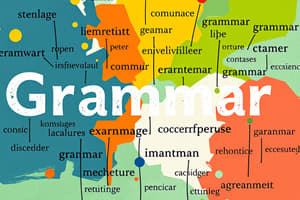Podcast
Questions and Answers
Which of the following is NOT a part of speech?
Which of the following is NOT a part of speech?
- Numbers (correct)
- Adverbs
- Conjunctions
- Nouns
English evolved solely from the Germanic language family.
English evolved solely from the Germanic language family.
False (B)
What are the four main types of writing?
What are the four main types of writing?
Expository, narrative, descriptive, persuasive.
Idioms and ________ are expressions that have a figurative meaning.
Idioms and ________ are expressions that have a figurative meaning.
Match the literary device with its definition:
Match the literary device with its definition:
Which of the following sentence types is used to ask a question?
Which of the following sentence types is used to ask a question?
Name two major influences on English vocabulary.
Name two major influences on English vocabulary.
Clarity and tone are important aspects of effective communication.
Clarity and tone are important aspects of effective communication.
Flashcards are hidden until you start studying
Study Notes
Overview of English Language
- Origin: English is a Germanic language that evolved from Old English, influenced by Norse and Norman French.
- Global Use: Widely spoken as a first language in countries like the USA, UK, Canada, Australia, and as a second language worldwide.
Language Structure
- Phonetics: Study of sounds; includes vowels and consonants.
- Grammar: Rules governing sentence structure:
- Parts of Speech: Nouns, pronouns, verbs, adjectives, adverbs, conjunctions, prepositions, interjections.
- Sentence Types: Declarative, interrogative, imperative, exclamatory.
- Tenses: Present, past, future; aspects include simple, continuous, perfect, and perfect continuous.
Vocabulary
- Word Formation:
- Root Words: Base words from which derivatives are formed.
- Prefixes and Suffixes: Added to change meaning or grammatical role.
- Synonyms and Antonyms: Words with similar or opposite meanings.
- Idioms and Phrasal Verbs: Expressions that have a figurative meaning.
Writing Skills
- Types of Writing:
- Expository, narrative, descriptive, persuasive.
- Structure:
- Introduction, body paragraphs, conclusion.
- Cohesion and Coherence: Use of transition words to link ideas and ensure clarity.
Reading Comprehension
- Strategies:
- Skimming for general ideas, scanning for specific information.
- Annotating texts for better retention and understanding.
- Literary Elements:
- Theme, character, setting, plot, conflict, and point of view.
Speaking and Listening
- Effective Communication: Clarity, tone, body language, and active listening skills.
- Pronunciation and Accent: Importance of clear articulation and understanding regional variations.
Literature
- Genres: Fiction, non-fiction, poetry, drama.
- Key Authors: Shakespeare, Jane Austen, Charles Dickens, F. Scott Fitzgerald, etc.
- Literary Devices: Metaphor, simile, alliteration, symbolism, etc.
Cultural Impact
- English as a Lingua Franca: Role in global communication, business, science, and technology.
- Influence on Other Languages: Loanwords and phrases adopted into other languages.
Language Variations
- Dialects and Accents: Regional differences in pronunciation and vocabulary.
- Standard vs. Non-standard English: Differences between formal writing/speech and colloquial forms.
Overview of English Language
- Originates from the Germanic language family, evolving from Old English, significantly influenced by Norse and Norman French.
- Considered a global language, used as a first language in the USA, UK, Canada, and Australia, while also serving as a second language in numerous countries.
Language Structure
- Phonetics encompasses the study of sounds in the language, distinguishing between vowels and consonants.
- Grammar involves rules of sentence structure, which include:
- Parts of Speech, such as nouns, verbs, adjectives, and more.
- Different types of sentences: declarative (statements), interrogative (questions), imperative (commands), exclamatory (emotional statements).
- Verb tenses include present, past, and future with aspects like simple, continuous, perfect, and perfect continuous.
Vocabulary
- Word formation starts with root words, forming derivatives through prefixes and suffixes that modify meaning or grammatical roles.
- Synonyms provide similar meanings, while antonyms offer opposite meanings.
- Idioms and phrasal verbs convey figurative meanings, enriching the language.
Writing Skills
- Types of writing include expository (informative), narrative (storytelling), descriptive (sensory details), and persuasive (argumentative).
- Writing structure typically comprises an introduction, body paragraphs, and a conclusion.
- Cohesion and coherence are maintained through transition words that link ideas for clarity in writing.
Reading Comprehension
- Employ skimming to grasp general concepts and scanning for specific details within texts.
- Annotating texts can enhance retention and comprehension.
- Important literary elements include theme, character, setting, plot, conflict, and point of view, which contribute to understanding narratives.
Speaking and Listening
- Effective communication requires clarity in speech, appropriate tone, body language awareness, and active listening skills.
- Pronunciation and accent play crucial roles in articulate speech, with recognition of regional variations influencing understanding.
Literature
- Major genres include fiction (narrative prose), non-fiction (informative texts), poetry (verses), and drama (plays).
- Notable authors are Shakespeare, Jane Austen, Charles Dickens, and F. Scott Fitzgerald, who significantly contributed to English literature.
- Literary devices such as metaphor, simile, alliteration, and symbolism enhance the expressive quality of texts.
Cultural Impact
- English serves as a lingua franca, facilitating global communication in business, science, and technology.
- Its influence extends to other languages, with numerous loanwords and phrases integrated worldwide.
Language Variations
- Language features various dialects and accents reflecting regional pronunciation and vocabulary differences.
- Distinctions exist between Standard English (formal communication) and Non-standard English (colloquial use), highlighting the diversity of the language.
Studying That Suits You
Use AI to generate personalized quizzes and flashcards to suit your learning preferences.




